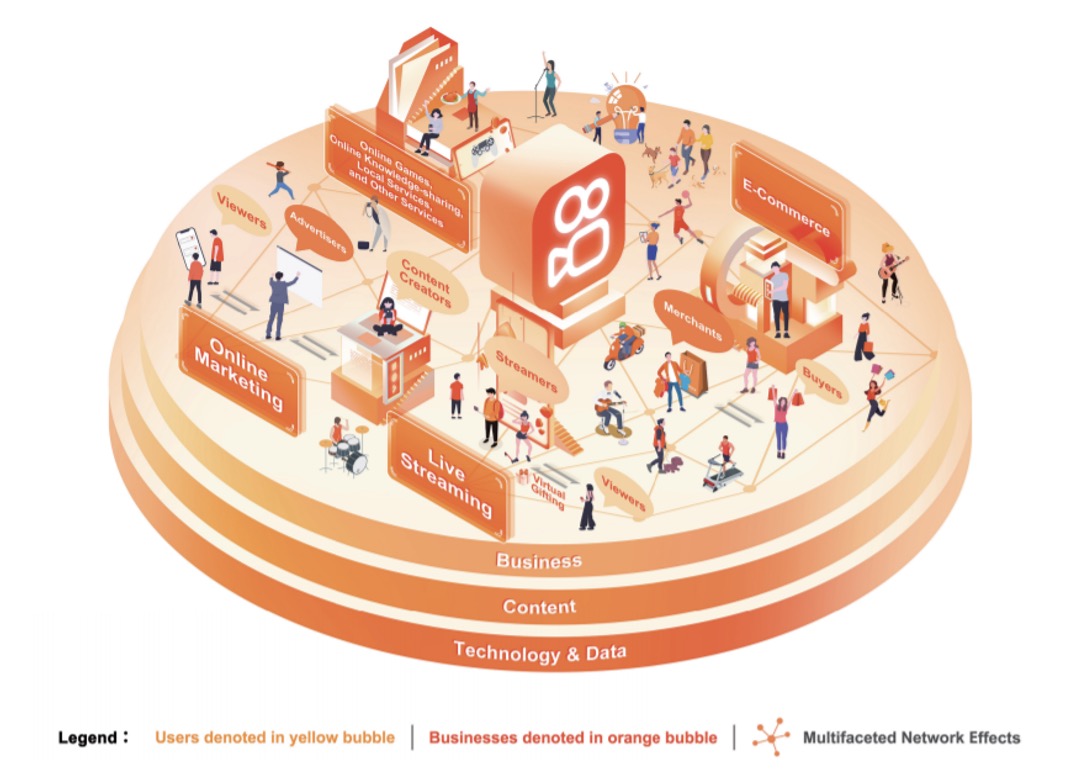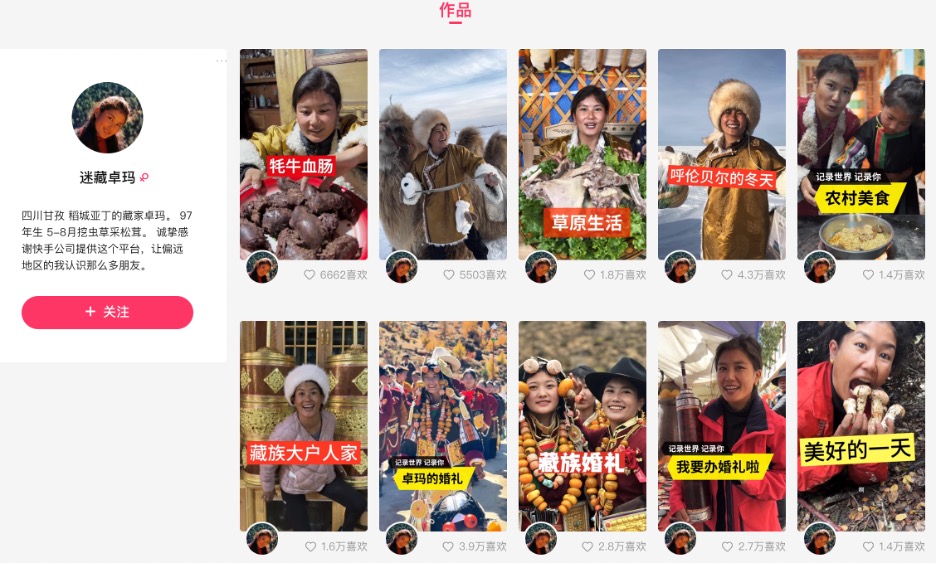Kuaishou, a massive short-video app that has already gone public, might not be widely recognized beyond China, unlike Douyin. For foreign investors, it could be perceived as just another Chinese tech unicorn that has undergone an IPO. Among Chinese urban dwellers, however, the app is often labeled as a 土tu (tacky) app, known for its content showcasing awkward moments and kitsch videos, particularly from rural China.
Despite its lack of global popularity, this short-video platform plays a crucial role in representing the diversity of “ordinary people” in China. The platform features individuals working on construction sites, residents of lower-tier cities, and those frequently overlooked by both media and brands. In a country where people dedicate an average of 2 hours and 12 minutes daily to social media, Kuaishou offers a distinctive space for genuine expressions and stories that extend beyond the glamour of urban life.
Kuaishou’s rise and market dominance: from a GIF generator to a social media giant
Founded in 2011 as a GIF creation and sharing app, Kuaishou transitioned into the short-video platform we know today in 2012-2013. Its growth surged in 2015, driven by increased smartphone and mobile network penetration, especially in rural and lower-tier cities. Live-streaming was integrated in 2016, and e-commerce services were launched in 2018.
Debuting on the stock market in 2021, Kuaishou boasts one of China’s most engaged youth demographics, with 300 million daily active users in 2023. A major rival to Douyin, the platform expanded its services beyond short video sharing, incorporating live-streaming and e-commerce. In Q2 2023, daily active users reached 376 million, marking an 8.3% YoY increase, establishing a new record high. Kuaishou offers a valuable channel for companies to connect with consumers living outside Tier-1 cities.
Today, short video sharing, live-streaming, and e-commerce constitute its three primary services. Like Douyin, of the platform is diversifying into other markets such as online education, knowledge sharing, and gaming.

What sets Kuaishou apart from the competition?
Residents of China’s major urban centers, including Beijing, Shanghai, and Shenzhen, often perceive Douyin as more user-friendly and relatable. Conversely, people in lower-tier cities such as Urumqi and Zhuhai tend to express a preference for the real-time video content offered by this Beijing-based tech company.
Indeed, while Douyin concentrates on showcasing individuals’ glamorous and luxurious lifestyles, Kuaishou promotes inclusivity by encouraging users to share various everyday life videos, spanning from cooking and cleaning to mundane and non-glamorous subjects. This inclusive approach allows even small and niche brands from rural areas to establish business accounts and garner substantial followings on the platform, often achieving higher user engagement rates than Douyin.
Rural livestreaming boom: how Chinese farmers thrive on Kuaishou
At the age of six, Ms. Geru Drolma (格绒卓姆) started harvesting fungi in the Qinghai-Tibet plateau, following her Tibetan parents’ footsteps to make a living. A video featuring her challenging work went viral on the platform fourteen years later, attracting half a million viewers and propelling her to fame. She gained 500,000 views and 3,000 new followers overnight after posting one of her first videos. Now with 2.14 million followers, Ms. Drolma, as a village vlogger, leverages her popularity to live stream and sell local farm produce, tapping into the growing trend of Kuaishou marketing.

She is part of the increasing cohort of farmers capitalizing on China’s flourishing e-commerce live-streaming trend. According to Kuaishou’s report in September 2023, the platform facilitated the sale of agricultural goods exceeding RMB 870 million through rural livestreams in 2022, marking a 55% year-on-year surge. Ministry of Commerce data for the first half of 2023 revealed that online retail sales of rural products reached RMB 1.12 trillion, reflecting a 12.5% year-on-year growth.
Why should brands market on Kuaishou?
In the second quarter of 2023, Kuaishou reported that the daily average time spent per DAU on the app was 117.2 minutes, showcasing a consistent increase in user engagement. During this period, online marketing services revenue accounted for 51.7% of the total revenue, reaching RMB 14.3 billion.
Tencent’s 2022 report underscores that residents in lower-tier cities exhibit double the enthusiasm for mobile shopping compared to their top-tier counterparts, indicating a substantial untapped market. This positions the Beijing-based tech company as a valuable avenue for brands looking to raise awareness and connect with consumers in rural and lower-tier areas. Collaborating with content creators from these regions on the platform offers brands an effective channel to showcase products, catering to users interested in authentic rural experiences.
Beyond short videos: Kuaishou’s dynamic e-commerce integration
Kuaishou’s e-commerce integration serves as a dynamic link between businesses and consumers, enhancing user engagement and driving sales.
Through captivating video content, brands effortlessly showcase their products, encouraging users to explore and make purchases. The collaboration with JD.com broadens the array of offerings, strengthening Kuaishou’s position as a valuable asset for revenue growth.
Moreover, since the launch of Kuaishou Global in 2020, foreign businesses not based in China can connect directly with Chinese consumers, utilizing the app’s seamless payment and logistics infrastructure. This innovative feature opens up exciting possibilities for foreign enterprises to access China’s growing middle-class in lower-tier cities.
Luxury brands find a home on Kuaishou
Historically, high-end brands, including luxury and premium cosmetics, faced challenges as consumers associated the app with a rural orientation, posing potential threats to their brand reputations. Nevertheless, the broadcast of Louis Vuitton’s Spring/Summer 2022 menswear show on the app indicated a shift. The LV show attracted 39 million viewers on the platform and 41 million viewers on Douyin, according to the brand.
While Douyin still achieves more views, international luxury brands are increasingly exploring the lower-tier market in China both offline and online by opening new stores in non-tier one cities and through platforms like Kuaishou.
Unveiling the untapped potential of Kuaishou
- Kuaishou provides a unique space for authentic expressions from overlooked demographics, fostering genuine connections beyond urban glamour.
- Starting as a GIF creation app, Kuaishou has grown into a major social media platform with 376 million daily active users, offering diverse services beyond short video sharing.
- The rise of rural livestreaming on Kuaishou presents opportunities for businesses, as seen in the platform’s role in facilitating significant agricultural sales.
- Kuaishou Global enables foreign businesses to tap into China’s vast consumer market, providing a seamless platform with unique payment and logistics infrastructure.
- Despite the initial stigma, luxury brands find success on Kuaishou, and the platform’s shift in perception makes it an attractive avenue, especially in untapped lower-tier markets.





